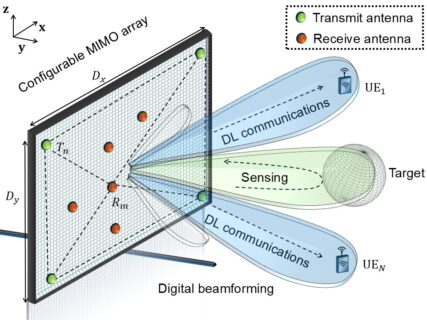Master Thesis — Optimization of Near-Field Integrated Radar Imaging and Downlink Communication Systems
Abstract:
As integrated sensing and communication (ISAC) emerges as a key enabler for sixth-generation (6G) wireless systems, efforts to refine its design and optimize its performance have intensified in recent years. Discussions on waveform design for multiple-input multiple-output (MIMO) ISAC remain ongoing, mainly due to the differing performance requirements of sensing and communication. In this context, orthogonal frequency-division multiplexing (OFDM), used in fourth- and fifth-generation (4G/5G) networks, can achieve a decent communication performance for communication-centric ISAC systems. This thesis investigates a MIMO-OFDM system that jointly enables radar imaging and communications. Similar to extremely large-scale MIMO (XL-MIMO) arrays, the proposed system operates in the near-field, allowing range-dependent focusing for high-resolution radar imaging. As shown in Figure 1, the radar imaging performance is optimized while satisfying downlink communication quality-of-service (QoS) requirements for single-antenna user equipment (UEs). Whereas most existing works emphasize classical performance metrics such as sensing rate (SR), Cramér–Rao bound (CRB), Fisher information matrix (FIM), and beampattern-based surrogates, this thesis evaluates the practical image quality through the point spread function (PSF), a key metric for assessing the focusing performance of a radar imaging system.
Guidelines for the project:
- Conduct targeted literature review.
- Model the system described above and identify the relevant degrees of freedom of the system (such as antenna positions, array geometry, and beamforming strategy) as well as an appropriate PSF-related performance metric.
- Formulate an optimization problem to optimize the radar imaging quality under downlink QoS constraints for the UEs.
- Propose a solution for the formulated optimization problem.
- Assess the solution quality via numerical simulations.
Prerequisites:
- Scientific skills: Interest in MIMO ISAC.
- Basic knowledge of sensing, wireless communications, and convex optimization.
- Programming skills: Experience in programming languages (Python and/or Matlab).
- Language skills: English fluency.
The complete project description can be found here. In case you are interested in pursuing this thesis, please contact Alireza Navi (alireza.navi@fau.de).
Supervisors:
